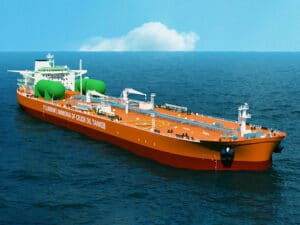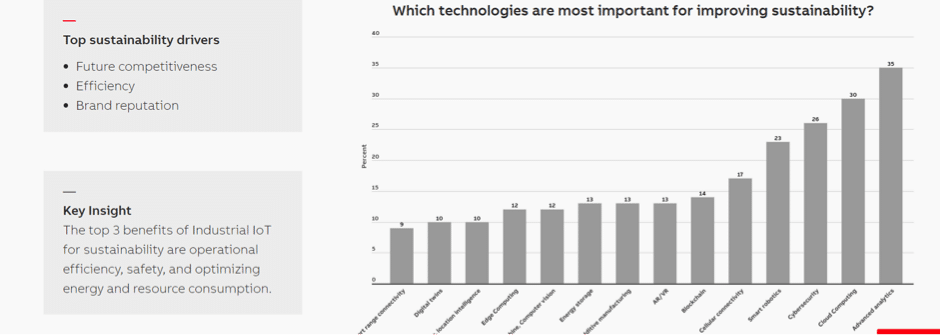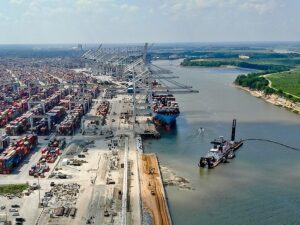
10 minutes with Jyri Jusslin of ABB on sustainability and digitalization
Written by Heather Ervin
Jyri Jusslin of ABB Marine & Ports talks sustainability and digitalization. (Credit: ABB)
As we continue to explore sustainability issues and solutions for the marine industry, we bring another edition of “10 Minutes With …” to get a new or different perspective on the topic. This week, we talked to Jyri Jusslin, head of service with ABB Marine & Ports on not just sustainability, but also on digitalization.
Jusslin is responsible for leading the division’s global service organization at more than 40 locations in 30 countries. Since joining ABB in 2001 to manage the service business for Marine & Ports, Jusslin has transformed the service organization from separate local units to a global team working together to support customers across regions, vessel segments and ports operations.
He has also played a key role in creating the concept of what is today known as ABB Ability™ Collaborative Operations driving digitalization of marine industry. Here’s more:
Marine Log (ML): ABB recently released its findings of a new global study on digitalization and sustainability. Can you briefly outline the top takeaways of that study and how it relates to maritime?
Jyri Jusslin (JJ): ABB commissioned a global research study that asked over 700 key decision-makers across 12 industrial segments how their businesses will address the challenges of digital transformation and sustainability. The study also offered insights into the steps ABB has taken to support customers in their journey towards decarbonization, both through the electrification of operations and by exploiting the benefits of the digitalization.
The top three technologies identified as enablers for digitalization are all very relevant to shipping. These were: cloud computing; advanced analytics; and cybersecurity solutions.
Today, many shipowners and operators already use digital solutions and services to improve the efficiency and safety of their operations, e.g. by collecting data from the ship’s onboard systems and external sources such as weather condition data, in order to optimize route planning and operational advice.
There are more and more solutions becoming available utilizing Artificial Intelligence (AI) and Machine Learning, which will ultimately make shipping operations more safe, efficient, and sustainable. For ABB many of these solutions come within the ABB Ability™ portfolio.
ML: How can marine shipping companies best leverage technology, such as the Internet of Things, to better attain sustainable goals?
IoT-based tools can be used in a number of ways to enhance sustainability, whether by increasing equipment efficiency, improving ship performance, supporting crew efficiency or capturing gains for independent verification. Typical benefits can be derived as follows:
- By getting actionable insights about weather using ‘advisory’ IoT-based tools, ship operators can avoid storms and plan their voyages more efficiently, predict estimated time of arrival more accurately, and minimize fuel consumption by operating at slower speeds.
- By utilizing situational awareness ships can operate more safely and efficiently in congested or busy port areas, or in bad weather conditions, enhancing flexibility in power management when the ship needs it most.
- IoT-based fleet management systems enable ship owners and managers to compare different operational profiles and apply lessons learnt across the fleet to emissions reduction strategies.
- In line with targets for shipping to cut C02 emissions, International Maritime Organization (IMO) measures come into force in 2023 which demand owners and operators offer measurable improvements in the efficiency achieved by and carbon intensity produced by ocean-going ships. Digitalization provides fast, cost-efficient and effective tools to gather and analyze data, make better operational decisions and reduce fuel consumption, but also to demonstrate compliance with automated “environmental reporting” tools.
ML: In what ways has ABB invested in digital capabilities that relate to its sustainability commitments?
ABB’s investments in digital capabilities are core to its sustainability commitments. With more than 70 percent of ABB’s R&D resources dedicated to digital and software innovations, and a robust ecosystem of digital partners, including Microsoft, IBM and Ericsson, the company has established a leading presence in Industrial IoT.
The ABB Ability™ portfolio of digital solutions enables a host of industrial use cases to power improvements in energy efficiency, resource conservation and circularity, including condition monitoring, asset health and management, predictive maintenance, energy management, simulation and virtual commissioning, remote support and collaborative operations.
Examples of ABB’s more than 170 Industrial IoT solutions include ABB Ability™ Genix industrial analytics and AI suite; ABB Ability™ Energy and Asset Manager; ABB Ability™ Condition Monitoring for Powertrains; and ABB Ability™ Connected Services for industrial robots.
ML: In your experience, how does the move toward sustainable shipping practices in the United States differ from the rest of the world (namely Europe and Asia)?
JJ: While the development towards sustainable shipping is a global phenomenon, there are, of course, regional differences. For example, the west coast in the United States has been leading shore connection initiatives to support zero emissions for ships in port, alongside the Northern Europe. In recent years this has become more of a topic in the rest of Europe and Asia, as well as for the US East coast.
The Bipartisan Infrastructure Deal will bring fundamental changes for US ports, airports, rail and roads to ensure the resilience and efficiency of supply chains from future shocks. Modern, resilient, and sustainable port, airport, and freight infrastructure will help improve efficiency, reduce costs, and support U.S. competitiveness by removing bottlenecks and expediting commerce, while reducing greenhouse gas emissions and the environmental impact on neighboring communities.
ML: Finally, how does the continued development of electric and hybrid vessels relate to all of this, and where do you see the adaption of these technologies in the U.S. over the next five years?
JJ: The continuous development of electric and hybrid vessels supports and drives the efforts for decarbonization. Electric technology provides a backbone for shipping which, combined with or further enhanced by digitalization, will accelerate development towards even more sustainable operations.
We do not think there is a single way to sustainability; rather we envisage a continuing effort from all companies within the industry to make their best efforts in 1) providing zero-emission technology, 2) leveraging available technologies, 3) and continuing to develop alternative solutions for ever-more restrictive compliance needs. Maritime stakeholders will need to work together, to reach the IMO’s goals for cutting emissions from ships by 2030 – and even more so for 2050 targets.
The adoption of digital technologies is increasingly widespread as more solutions become available, and as ROIs become faster and more attractive, a “want” has become a need for change. Certainly, where the maritime space is concerned, we expect the pace of adoption to continue ramping up.
According to Clarkson’s Market Intelligence Report 2021:
- Market for digital products and services forecasted to be worth $345bn by 2030, a significant increase from previous forecast of $279 bn.
- Digitalization in shipping means creating value out of available data. The recent big steps within digitalization will be seen in the maritime industry despite the industry’s ambivalent relationship to new technologies. We see companies within the maritime industry increase their references to digitalization in their filings (up 421% since 2016).
- Digitalization will slowly force the maritime community to look deeper into the relations between stakeholders such as the IMO, classification societies, insurance companies and manufacturers. The whole regulatory framework continues to face a fundamental shift from descriptive rule developments towards a goal-based risk assessment analysis. This will result in a complete remodeling of the business models and the clarification of demarcation lines between the stakeholders.





